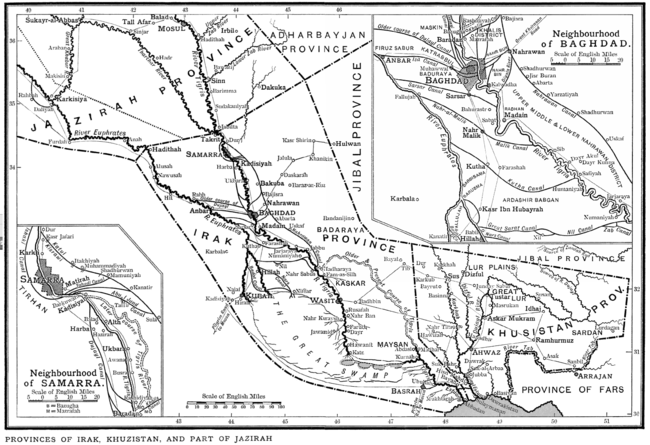Sawad
Sawad was the name used in early Islamic times (7th–12th centuries) for southern Iraq. It means "black land" or "arable land"[1] and refers to the stark contrast between the alluvial plain of Mesopotamia and the Arabian Desert. Under the Umayyad and Abbasid Caliphates, it was an official political term for a province encompassing most of modern Iraq except for the Syrian Desert and Upper Mesopotamia in the north.

Map of the Sawad ("Iraq") under the Abbasid Caliphate
As a generic term in Arabic and Persian, sawād (سواد) was used to denote the irrigated and cultivated areas in any district. Unmodified, it always referred to southern Iraq, the sawād of Baghdad. It replaced the earlier and more narrow term Rādhān.
Sources
- Schaeder, H.H. (1997). "Sawād". In Bosworth, C. E.; van Donzel, E.; Heinrichs, W. P. & Lecomte, G. (eds.). The Encyclopaedia of Islam, New Edition, Volume IX: San–Sze. Leiden: E. J. Brill. p. 87. ISBN 90-04-10422-4.
- Michele Campopiano, “Land Tax Alā l-misāḥa and muqāsama: Legal Theory and Balance of Social Forces in Early Medieval Iraq (Sixth to Eighth Centuries)”, in Journal of the Economic and Social History of the Orient, 54/2, 2011, 239-269
gollark: Anyway, some of the text implies that defenses do actually work, which is odd.
gollark: Yay, level 14!
gollark: Now to just build a stupid amount of snow cannons and minmax this to death.
gollark: Also, all my weapons are greyed out in the battle view thingy, can I fix them somehow?
gollark: Do the walls actually *do* anything?
References
- Wehr, Hans (1979). A Dictionary of Modern Written Arabic. Otto Harrassowitz Verlag. p. 513. ISBN 978-3-447-02002-2.
This article is issued from Wikipedia. The text is licensed under Creative Commons - Attribution - Sharealike. Additional terms may apply for the media files.